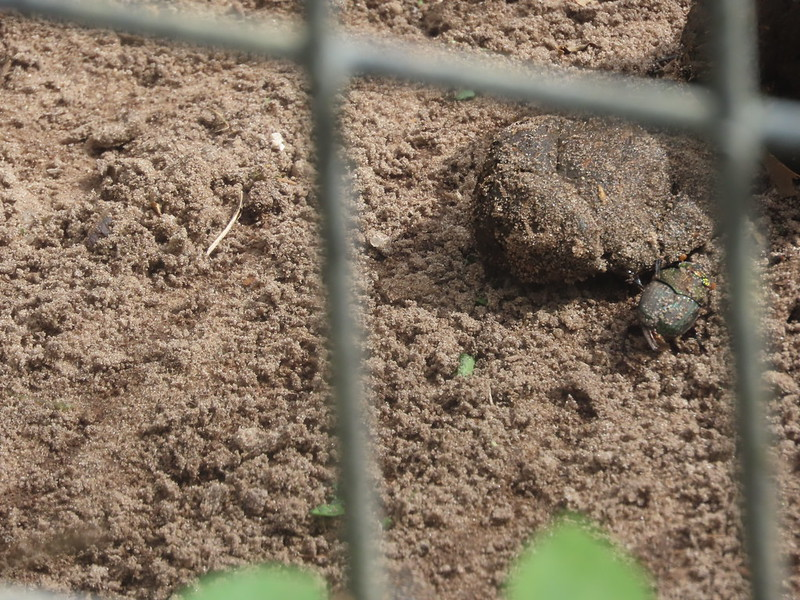A story of sand and shit.
🙂

Rainbow Scarab, found in the Red River Hog enclosure at the Zoo Tampa
Florida is full of bullshit. No, not just THAT kind—I mean real actual bullshit. Many of Florida’s early settlers were cattle ranchers who inhabited the open grassland habitat that once filled most of the central peninsula. Because they would drive their herds of cattle along by cracking a long bullwhip over their heads, these ranchers became known as “Crackers”. Even today, Florida is the home of a major ranching industry, and by some counts the Sunshine State has more cattle than Texas.
By the late 1960s, Florida had almost two million beef and dairy cattle. As you can imagine, all those animals produced a lot of poop, and given Florida’s dry and loose sandy soil, it took a long time for that mess to naturally decay–and in the meantime it attracted clouds of dung-loving flies. State officials began to worry about the potential for spreading both cattle and human diseases, and since there weren’t enough ranch hands with shovels to deal with the problem, they sought a good way to remove all that poop easily and quickly using natural methods.
They settled on the Dung Beetles.
There are around 10,000 species of Dung Beetle spread across virtually every grassland and prairie habitat on the planet. They are not a single evolutionary group, and dung-eaters can be found in several different families of beetle, but the most common are the scarabs in the group Scarabaeidae, who ply their trade in dung from a variety of mammals ranging from Elephants to Raccoons. In North America, around 170 species of Dung Beetles can be found, and a couple dozen of these are native to Florida. These include Phanaeus vindex, or Rainbow Scarab, a large green beetle that ranges across the southeastern US, as well as Peltotrupes profundus, a black beetle in the “Earth-Boring Beetles” family which is found only in Florida. It is known as the Florida Deepdigger Scarab.
Florida’s native Dung Beetles, it was found, were not sufficient to deal with the cow poop problem. Although Florida was populated in historical times by large mammals such as Bison, Black Bears and Deer, these were never present in very large numbers, and the native beetles had not evolved to keep up with such large numbers of poop-producers. So in the early 1970s state agricultural authorities began studying the possibility of importing more active Dung Beetles from Africa and Asia, and eventually selected 23 species for deliberate introduction. In the years since then, moreover, at least 22 additional species have been found in Florida, having been accidentally introduced through potted plants or agricultural supplies. At least four of these, Digitonthophagus gazella, Onthophagus taurus, Euoniticellus intermedius, and Aphodius fimetarius, have now become invasives and have spread across suitable habitats in the Americas and Australia—including Florida. In some places, like Brazil, these invaders have already replaced a number of native beetles.
The most commonly-seen Dung Beetle in Florida is the Rainbow Scarab. It ranges naturally in North America through the Great Plains and from New England down to Florida, making them the most wide-ranging of the North American species. Typical Rainbow Scarabs are about an inch long and have bright iridescent green abdomens and a thorax that is bright coppery-pink. The males have a conspicuous black “horn” on the head that curves back over the thorax, and they come in two distinct body forms, with one noticeably larger and with a longer horn than the other. There is also a similar but smaller species, P. difformis, which shares much of the same habitat, and the two species sometimes hybridize.
The adult beetles feed on plant material such as dropped fruits. But they are readily attracted to the fresh droppings of large mammals, which they can smell at considerable distances, and which they use as a nursery. Each mated pair will dig a deep tunnel and roll a pat of poop into a series of small balls, upon which they lay eggs before burying the whole mess underground. The eggs hatch into grubs which feed on the dung, drawing their nutrients from the undigested food that the poop contains. The grubs pupate underground and emerge as adults. In winter, the larvae remain dormant in their poop shelter until spring.
Florida’s Dung Beetles are preyed upon by many midsized predators. One of these is the Burrowing Owl, which often places pieces of fresh dung or ripe fruit near the entrance to their burrow, thereby luring the Dung Beetles into striking range.
